Sacred Mountains of Japan, with a Particular Look at the Shikoku Pilgrimage
DOWNLOAD PDF
Japan is an island country, blessed with many peaks rising up to the clouds. It should come as no surprise that many of the mountains of Japan are treated as sacred spaces, and that visiting those heights may be an act of worship in and of itself. Of course, though we can think of all mountains as sacred, it is important to note that some are particularly venerated as holy peaks, or reizan.
Mt. Fuji, probably the best-known of Japanese mountains, is the home of a Shintō goddess, the center of a cult of climbers, and the object of thousands of painted and printed depictions. Mt. Hiei, just northeast of Kyoto, was considered a spiritual protector, home of Bishamon-ten, the Buddhist guardian of that geographic quadrant, and able to ward off the most powerful winter storms. Mt. Kōya, south and east of both Kyoto and the even older capital at Nara, is a complex of peaks and secluded valleys. In the early ninth century, the eminent Buddhist priest Kūkai (774–835), commonly known by his posthumous name Kōbō Daishi, chose Mt. Kōya as the site for his mountain retreat that eventually grew into the center for the Buddhist Shingon sect. These and other peaks are centers of shugendō, an eclectic religious practice in which yamabushi, “mountain ascetic,” priests travel or reside in the mountains to undertake austerities and build their spiritual (one might say “magical”) power. Sites of shugendō practice range from the three peaks of the Dewa Sanzan in the north to Mt. Kurama near Kyoto and Mt. Yoshino near Nara to the rocky precipice of Mt. Hiko in Kyushu. Yet other peaks, including Mt. Kompira in northern Shikoku, are the domains of Shinto institutions, but all these mountains are venerated by believers of many religious persuasions. Historically, in fact, the distinctions between Buddhist and Shinto were blurred, so even today a visit to any summit may be considered an act of worship, of benefit to both the pilgrim and the community, and perhaps a blessing to the mountain itself.
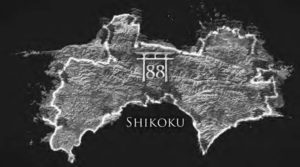 Illustration of Shikoku. The bright
Illustration of Shikoku. The brightwhite line inside the coastline is the
route of the Shikoku Pilgrimage.
Source: Screen capture from Shikoku
Pilgrimage documentary on YouTube at
http://tinyurl.com/jlsj4ze.
Shikoku and the Eighty-Eight-Temple Pilgrimage
In this article, I take a special look at sacred mountains in Shikoku, the smallest of Japan’s four main islands. The name Shikoku means “four provinces,” and since the 1870s, it has been composed of four prefectures corresponding to the original four provinces of earlier times. Tokushima, formerly Awa Province, is in the northeast corner of the island. Kōchi, formerly Tosa Province, is the largest of the four, spreading across the southern side of the island from end to end. Ehime, once Iyo Province, is in the northwest and is perhaps the most agriculturally rich. Kagawa is the smallest in terms of area, but more densely populated than the other regions. Each of these prefectures has its own character, as well as its own particularly sacred mountains. The four former provinces are, moreover, long tied together by a pilgrimage route connecting eighty-eight sites linked to the life of Kōbō Daishi, one of early Japan’s most revered figures. The temples of the pilgrimage also function as a mandala, or map of the spiritual universe, in this case a spiritual diagram laid over the real physical landscape. One of the most important of the Shingon school of Buddhism’s rituals is chanting the mandala, that is, chanting the mantra (Japanese shingon) sound specific to each deity represented in the diagram; pilgrims (henro) chant (among other things) the mantra of the main deity at each temple they visit, reenacting the ritual across the mandala of the real landscape.
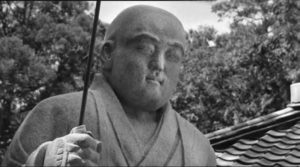 Larger-than-life statue of Kūkai at
Larger-than-life statue of Kūkai atZentsū-ji Temple—his birthplace.
Source: Screen capture from the Shikoku
Pilgrimage documentary on YouTube at
http://tinyurl.com/jlsj4ze.
The illustrious monk Kūkai was born at Byōbugaura in Sanuki Province in 771.1 He began to study Chinese by the time he was fifteen and at twenty moved to the capital at Heijō (modern Nara), where he became interested in Buddhism, particularly in the practice of chanting the mantras associated with specific deities. Within a few years, the capital was moved to Heian (modern Kyoto), and Kūkai spent several years in private Buddhist practice there, often meditating and chanting in the mountains. After a vision, he began to study the Mahavairocana sūtra (J. Dainichikyō), probably composed in northeastern India in the seventh century and transmitted to China. However, there was no complete translation of the text available in Japan, so Kūkai sought an opportunity to travel to China for further study. He joined an official mission in 804 and went to Chang’an (modern Xian), where he studied Sanskrit under both South Asian and Chinese teachers. He returned to Japan in 806 after receiving initiation at the highest level of esoteric Buddhism, eventually establishing the Shingon sect headquarters at Kongōbuji on Mt. Kōya, where he died (or, according to Shingon tradition, entered eternal
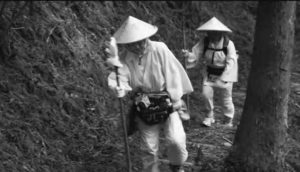 Pilgrims walk a steep mountian
Pilgrims walk a steep mountianpath toward a temple. Source: Screen
capture from Shikoku Pilgrimage documentary
on YouTube at
http://tinyurl.com/jlsj4ze.
meditation) in 835.
Many Shikoku sites are associated with Kōbō Daishi in local tradition, though only a few are mentioned in his voluminous writings. By the sixteenth century, a route connecting eighty-eight temples in the four provinces, as well as an extended route including twenty “alternate” temples, had been established. The route was further codified during early modern times in response to governmental travel restrictions and became popular in part as a means for ordinary people to experience the joys of travel.2 The journey covers almost 800 miles, and a complete list of the temples is available on Wikipedia, among other places.3 The course of the pilgrimage is divided into four metaphorical stages, each corresponding to one of the four provinces. The twenty-three Awa temples are linked to hosshin, the arousal of spiritual fervor; the long path through Tosa represents disciplinary training, shugyō; Iyo is connected to spiritual awakening or enlightenment, bodai; and Sanuki is linked to the attainment of nirvana or liberation, nehan. As a consequence, the act of walking the pilgrimage route reenacts the spiritual journey of Siddhartha becoming the Buddha in northern India during the fifth century BCE, moving through both time and space as the pilgrim traces the steps of the mandala.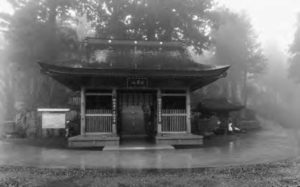 Unpenji gate appearing in the rain. Source: Photo courtesy of the author.
Unpenji gate appearing in the rain. Source: Photo courtesy of the author.
A full formal pilgrimage begins with a trip to Mt. Kōya to profess a vow to visit all the eighty-eight (or 108) temples on the route. Though pilgrims may start or end at any of the 108 temples, most begin at temple one, Ryōzenji, and finish at temple eighty-eight, Ōkuboji. Pilgrims wear white vests or jackets inscribed with the mantra of Kōbō Daishi; they carry wooden staffs that symbolize the support of Kōbō Daishi along the journey. Pilgrims may also wear basketry hats on the road and when visiting temples put on abbreviated surplices and carry rosaries of wooden beads. After completing the circuit, many pilgrims revisit the temple where they began, usually Ryōzenji, where a formal list of pilgrim names is maintained, and finally return to Mt. Kōya to thank Kōbō for his help in making the journey. Some experienced pilgrims, particularly in leap years, reverse the order of the trip, beginning at Ōkuboji and moving counterclockwise. Some walk the entire route in one attempt, while others traverse the path in stages; one example of that would be when the pilgrim traverses the route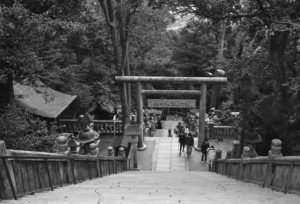 Looking down the 1,368 steps on
Looking down the 1,368 steps on
Mt. Konpira that lead to the Kotohira
Shrine. Source: From Yoshikazu
Takada page on Flickr at http://tinyurl.
com/hdosvkm.
province by province. Traditionally, the journey was accomplished on foot, but today, pilgrims use bicycles, motorcycles, cars, trains, or tour buses. Even for those who vow to walk the whole path, in a few places, since supposedly Kōbō used ferryboats, it is acceptable to ride them. Among those who walk, it was reported to me that until the 1990s, many pilgrims walked in groups of three to eight, but in recent years, most walk alone or with a single companion.4
Nine sections of the path, called henro-korogashi, “places that make pilgrims fall over,” are considered especially difficult, and each is associated with a particularly sacred mountain. These sections are all mountain trails, unlike the majority of the route, which has been paved in the process of building modern highways. The path to temple twelve, Shōsanji, near the peak of Mt. Shōsanji, is the first of these difficult sections encountered by most pilgrims. The paths to temple twenty, Kakurinji, and from there to temple twenty-one, Tairyūji, are difficult climbs in rapid succession; many visitors who are not walking pilgrims take the ropeway up to the peak of Mt. Tairyū. Though most of the pilgrimage in Kōchi Prefecture is relatively flat, the 450-meter climb to temple twenty-seven, Kōnomineji, is steep. Temple sixty, Yokomineji, has one of the longest climbs in terms of distance, while temple sixty-six, Unpenji, is the highest on the whole route. The path up to temple eighty-one, Shiromineji, and the path between that and temple eighty-two, Negoroji, are both difficult, while temple eighty-four, Yashimaji, sits atop a rooflike peak that was once a separated island but today is connected to the mainland by landfill. Finally, the route to Ōkuboji goes directly over the peak of Mt. Nyotai, and the pilgrim must climb straight up the rock face to finish the pilgrimage. Mt. Tairyū, Mt. Unpen, Mt. Shiromine, Mt. Yashima, and Mt. Nyotai all are sacred peaks in the shugendō tradition, with historical associations as well.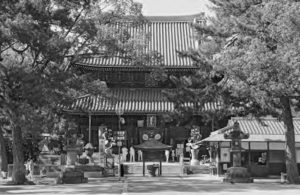 Zentsū-ji Temple number seventy-
Zentsū-ji Temple number seventy-
five, and the birthplace of Kūkai.
Source: Photo by 663highland on
Wikimedia Commons at http://tinyurl.
com/juohn55.
In February and March 2016, I experienced each of these mountains by completing a pilgrimage in one attempt. Some moments, such as climbing into the clouds of Mt. Unpen with two other pilgrims, were truly magical. “Unpen,” after all, means “near the clouds,” and it was raining intermittently throughout our ascent. This could have been a truly miserable day—not only were we wet and tired, but the rain fell on paths of rock and clay covered by dried leaves that had fallen from the trees. The leaves were slippery, the clay was slippery, and even the rocks were slippery, but climbing up went fairly quickly and relatively well. We emerged from the wooded path into a meadow shrouded in heavy clouds and made our way to the temple, which almost miraculously appeared before us. Coming down was, of course, a different story—each of the three of us fell to the muddy ground at least once during the descent.
The other big peaks were also special in their own ways. We arrived at temple twelve, Shōsanji, near the end of our third day on the road, and sudden rain came on us as we climbed, so it was a relief to dry out even for a bit. We were also still adjusting to the hard schedule of walking pilgrims. Though both temple twenty, Kakurinji, and temple twenty-one, Tairyūji, are at the top of 500-meter climbs (approximately 1,640 feet), with a 500-meter descent between them, we managed both in one day. Tairyūji had a particularly serene atmosphere, perhaps because we stopped walking for the day there and took the ropeway down to our lodging house immediately after. We took the ropeway back up the next morning. At temple sixty, Yokomineji, there was snow on the ground, but only in the area of the temple itself. Though not a difficult site, temple fifty-eight, Sen’yūji, sits at the top of an incredibly rickety concrete staircase punctuated by ancient-looking statues of Buddhist deities. Finally, the route to Ōkuboji seemed designed as a trial of the most physical sort, over the bare rocks of Mt. Nyotai (the name means “woman’s body”) and symbolically through a birth canal of steep stairs to completion of the route.
In addition to these peaks on the pilgrimage route, Shikoku has other sacred mountains. The highest and, according to some, most powerful of the holy mountains of Shikoku is Mt. Ishizuchi in Ehime; the peak is nearly 2,000 meters (approximately 6,562 feet) above sea level. Shikoku’s largest and most popular Shinto shrine, the Kotohiaragū, known in the vernacular as Kompirasan (Mt. Kompira), looms over Kagawa Prefecture at the top of a stairway of 1,368 steps. Many devotees undertake the climb up those stairs annually to purify themselves in the hope of securing mystical aid to commercial fruition, travel safety, or educational success. At Yashima, I met people who climb a two-kilometer, twenty-degree steep slope daily to visit the Inari shrine inside the Buddhist temple at the top and pray for commercial fortune.
Believers undertake these journeys for many reasons. Of course there is a search for good karma and a desire to accumulate spiritual merit, but individuals have other powerful motives as well. Pilgrims may be grieving for lost family members, seeking personal awakening or physical strength, or even trying to avoid a troubling situation at home. In Japanese tradition, such religious discipline is often private, and though family and friends may celebrate the completion of a pilgrimage, there is rarely any other public announcement of the endeavor.
On the other hand, the community participates in the journey as well. When ordinary people meet a pilgrim, they may offer gifts such as a piece of hard candy from a child (in our case, his parents stopped their car to make the encounter possible), amulets for spiritual protection, discounts on lodging and meals, or even cold cash. Another significant aid to the pilgrim who has lost the path (despite the many signs posted along it) is that Shikoku residents are exceptionally generous in pointing out directions. Finally, there is community pride in the henromichi, or “pilgrim path,” perhaps best signified by the movement to make the eighty-eight-temple pilgrimage a United Nations Educational, Scientific, and Cultural Organization (UNESCO) World Heritage monument.
The sacred mountains of Japan call out to many pilgrims. Thousands of Japanese, and hundreds of visitors from other countries undertake the climb up Mt. Fuji each summer. Thousands more participate in the Shikoku pilgrimage, with an estimated 3,000 to 4,000 walking the route each year, perhaps 100 of whom are non-Japanese. While some of this popularity reflects the international culture of hiking and nature worship worldwide, there is a particularly strong call for a path immersed in natural beauty and linked to spiritual power. Like the Camino de Santiago in France and Spain, the Shikoku pilgrimage route is one such path connecting a series of sacred mountains and steeped in tradition, but profoundly relevant to contemporary environmental consciousness.
meditation) in 835.
Many Shikoku sites are associated with Kōbō Daishi in local tradition, though only a few are mentioned in his voluminous writings. By the sixteenth century, a route connecting eighty-eight temples in the four provinces, as well as an extended route including twenty “alternate” temples, had been established. The route was further codified during early modern times in response to governmental travel restrictions and became popular in part as a means for ordinary people to experience the joys of travel.2 The journey covers almost 800 miles, and a complete list of the temples is available on Wikipedia, among other places.3 The course of the pilgrimage is divided into four metaphorical stages, each corresponding to one of the four provinces. The twenty-three Awa temples are linked to hosshin, the arousal of spiritual fervor; the long path through Tosa represents disciplinary training, shugyō; Iyo is connected to spiritual awakening or enlightenment, bodai; and Sanuki is linked to the attainment of nirvana or liberation, nehan. As a consequence, the act of walking the pilgrimage route reenacts the spiritual journey of Siddhartha becoming the Buddha in northern India during the fifth century BCE, moving through both time and space as the pilgrim traces the steps of the mandala.
 Unpenji gate appearing in the rain. Source: Photo courtesy of the author.
Unpenji gate appearing in the rain. Source: Photo courtesy of the author.A full formal pilgrimage begins with a trip to Mt. Kōya to profess a vow to visit all the eighty-eight (or 108) temples on the route. Though pilgrims may start or end at any of the 108 temples, most begin at temple one, Ryōzenji, and finish at temple eighty-eight, Ōkuboji. Pilgrims wear white vests or jackets inscribed with the mantra of Kōbō Daishi; they carry wooden staffs that symbolize the support of Kōbō Daishi along the journey. Pilgrims may also wear basketry hats on the road and when visiting temples put on abbreviated surplices and carry rosaries of wooden beads. After completing the circuit, many pilgrims revisit the temple where they began, usually Ryōzenji, where a formal list of pilgrim names is maintained, and finally return to Mt. Kōya to thank Kōbō for his help in making the journey. Some experienced pilgrims, particularly in leap years, reverse the order of the trip, beginning at Ōkuboji and moving counterclockwise. Some walk the entire route in one attempt, while others traverse the path in stages; one example of that would be when the pilgrim traverses the route
 Looking down the 1,368 steps on
Looking down the 1,368 steps onMt. Konpira that lead to the Kotohira
Shrine. Source: From Yoshikazu
Takada page on Flickr at http://tinyurl.
com/hdosvkm.
province by province. Traditionally, the journey was accomplished on foot, but today, pilgrims use bicycles, motorcycles, cars, trains, or tour buses. Even for those who vow to walk the whole path, in a few places, since supposedly Kōbō used ferryboats, it is acceptable to ride them. Among those who walk, it was reported to me that until the 1990s, many pilgrims walked in groups of three to eight, but in recent years, most walk alone or with a single companion.4
Nine sections of the path, called henro-korogashi, “places that make pilgrims fall over,” are considered especially difficult, and each is associated with a particularly sacred mountain. These sections are all mountain trails, unlike the majority of the route, which has been paved in the process of building modern highways. The path to temple twelve, Shōsanji, near the peak of Mt. Shōsanji, is the first of these difficult sections encountered by most pilgrims. The paths to temple twenty, Kakurinji, and from there to temple twenty-one, Tairyūji, are difficult climbs in rapid succession; many visitors who are not walking pilgrims take the ropeway up to the peak of Mt. Tairyū. Though most of the pilgrimage in Kōchi Prefecture is relatively flat, the 450-meter climb to temple twenty-seven, Kōnomineji, is steep. Temple sixty, Yokomineji, has one of the longest climbs in terms of distance, while temple sixty-six, Unpenji, is the highest on the whole route. The path up to temple eighty-one, Shiromineji, and the path between that and temple eighty-two, Negoroji, are both difficult, while temple eighty-four, Yashimaji, sits atop a rooflike peak that was once a separated island but today is connected to the mainland by landfill. Finally, the route to Ōkuboji goes directly over the peak of Mt. Nyotai, and the pilgrim must climb straight up the rock face to finish the pilgrimage. Mt. Tairyū, Mt. Unpen, Mt. Shiromine, Mt. Yashima, and Mt. Nyotai all are sacred peaks in the shugendō tradition, with historical associations as well.
 Zentsū-ji Temple number seventy-
Zentsū-ji Temple number seventy-five, and the birthplace of Kūkai.
Source: Photo by 663highland on
Wikimedia Commons at http://tinyurl.
com/juohn55.
In February and March 2016, I experienced each of these mountains by completing a pilgrimage in one attempt. Some moments, such as climbing into the clouds of Mt. Unpen with two other pilgrims, were truly magical. “Unpen,” after all, means “near the clouds,” and it was raining intermittently throughout our ascent. This could have been a truly miserable day—not only were we wet and tired, but the rain fell on paths of rock and clay covered by dried leaves that had fallen from the trees. The leaves were slippery, the clay was slippery, and even the rocks were slippery, but climbing up went fairly quickly and relatively well. We emerged from the wooded path into a meadow shrouded in heavy clouds and made our way to the temple, which almost miraculously appeared before us. Coming down was, of course, a different story—each of the three of us fell to the muddy ground at least once during the descent.
The other big peaks were also special in their own ways. We arrived at temple twelve, Shōsanji, near the end of our third day on the road, and sudden rain came on us as we climbed, so it was a relief to dry out even for a bit. We were also still adjusting to the hard schedule of walking pilgrims. Though both temple twenty, Kakurinji, and temple twenty-one, Tairyūji, are at the top of 500-meter climbs (approximately 1,640 feet), with a 500-meter descent between them, we managed both in one day. Tairyūji had a particularly serene atmosphere, perhaps because we stopped walking for the day there and took the ropeway down to our lodging house immediately after. We took the ropeway back up the next morning. At temple sixty, Yokomineji, there was snow on the ground, but only in the area of the temple itself. Though not a difficult site, temple fifty-eight, Sen’yūji, sits at the top of an incredibly rickety concrete staircase punctuated by ancient-looking statues of Buddhist deities. Finally, the route to Ōkuboji seemed designed as a trial of the most physical sort, over the bare rocks of Mt. Nyotai (the name means “woman’s body”) and symbolically through a birth canal of steep stairs to completion of the route.
In addition to these peaks on the pilgrimage route, Shikoku has other sacred mountains. The highest and, according to some, most powerful of the holy mountains of Shikoku is Mt. Ishizuchi in Ehime; the peak is nearly 2,000 meters (approximately 6,562 feet) above sea level. Shikoku’s largest and most popular Shinto shrine, the Kotohiaragū, known in the vernacular as Kompirasan (Mt. Kompira), looms over Kagawa Prefecture at the top of a stairway of 1,368 steps. Many devotees undertake the climb up those stairs annually to purify themselves in the hope of securing mystical aid to commercial fruition, travel safety, or educational success. At Yashima, I met people who climb a two-kilometer, twenty-degree steep slope daily to visit the Inari shrine inside the Buddhist temple at the top and pray for commercial fortune.
Believers undertake these journeys for many reasons. Of course there is a search for good karma and a desire to accumulate spiritual merit, but individuals have other powerful motives as well. Pilgrims may be grieving for lost family members, seeking personal awakening or physical strength, or even trying to avoid a troubling situation at home. In Japanese tradition, such religious discipline is often private, and though family and friends may celebrate the completion of a pilgrimage, there is rarely any other public announcement of the endeavor.
On the other hand, the community participates in the journey as well. When ordinary people meet a pilgrim, they may offer gifts such as a piece of hard candy from a child (in our case, his parents stopped their car to make the encounter possible), amulets for spiritual protection, discounts on lodging and meals, or even cold cash. Another significant aid to the pilgrim who has lost the path (despite the many signs posted along it) is that Shikoku residents are exceptionally generous in pointing out directions. Finally, there is community pride in the henromichi, or “pilgrim path,” perhaps best signified by the movement to make the eighty-eight-temple pilgrimage a United Nations Educational, Scientific, and Cultural Organization (UNESCO) World Heritage monument.
The sacred mountains of Japan call out to many pilgrims. Thousands of Japanese, and hundreds of visitors from other countries undertake the climb up Mt. Fuji each summer. Thousands more participate in the Shikoku pilgrimage, with an estimated 3,000 to 4,000 walking the route each year, perhaps 100 of whom are non-Japanese. While some of this popularity reflects the international culture of hiking and nature worship worldwide, there is a particularly strong call for a path immersed in natural beauty and linked to spiritual power. Like the Camino de Santiago in France and Spain, the Shikoku pilgrimage route is one such path connecting a series of sacred mountains and steeped in tradition, but profoundly relevant to contemporary environmental consciousness.
Sacred Mountains of Japan: Resources for Educators (Textbox in Article)
Background information on sacred sites in Japan is widely available. The best Internet source on the Shikoku pilgrimage is Jeffrey Hackler’s “Brief Shikoku Pilgrimage ‘English’ Guide” on Mandela Net at http://tinyurl. com/zlwmhkp. As he suggests, many books are available about the circuit, from Oliver Statler’s Japanese Pilgrimage (New York: William Morrow & Company, 1983) to Robert Sibley’s The Way of the 88 Temples: Journeys on the Shikoku Pilgrimage (Charlottesville: university of Virginia Press, 2013). A respectable list appears on the Wikipedia page (http://tinyurl.com/jv2oelc), along with a complete table of the eighty-eight temples and links to a variety of other sources.
Three films about Japanese sacred mountains are particularly interesting: Arukihenro from 2008, and Shugendō Now! and Where Mountains Fly from 2010. Arukihenro (http://tinyurl.com/jzs3k2y) explores the journeys of contemporary pilgrims around Shikoku. Shugendō Now! (http://tinyurl.com/gsa552p) offers a striking look at the practices of mountain monks, with great insight into how traditional practice(s) can be integrated into modern life. Where Mountains Fly (http://tinyurl.com/zlzw8wq) takes a more artistic approach, incorporating emaki scroll painting imagery with real landscapes to tell the story of En-no-gyōja (634–ca. 707), legendary founder of the shugendō ascetic discipline. The underlying theme of each of these films is living tradition, and each explores the ways in which practitioners in the twenty-first century can utilize the rituals surviving from the past to deal with the complexities of the present. One episode of Bruce Feiler’s 2014 PBS documentary series Sacred Journeys is also concerned with the Shikoku pilgrimage; see http://tinyurl.com/n5of67m for details.
NOTES 1. Details of Kōbō Daishi’s life follow Yoshito S. Hakeda, Kūkai and His Major Works (New York: Columbia University Press, 1972) and Ryuichi Abe, The Weaving of Mantra: Kūkai and the Construction of Esoteric Buddhist Discourse (New York: Columbia University Press, 1999). 2. Natalie Kouamé, “Shikoku’s Local Authorities and Henro during the Golden Age of the Pilgrimage,” Japanese Journal of Religious Studies 24, no. 3 (1997): 415–426. 3. “Shikoku Pilgrimage,” Wikipedia, accessed October 19, 2016, http://tinyurl.com/zrqw3ls. 4. Conversation with the proprietor of Yasokubo Minshuku, March 23, 2016.
FRANK L. CHANCE is a scholar of East Asian art. From 2002 until 2015, he served as the Associate Director for Academics of the Center for East Asian Studies at the University of Pennsylvania. Among his recent publications is a chapter in Japan Emerging: Premodern History to 1850, edited by Karl Friday, on the pleasures of urban life in the early modern period. Chance has curated exhibitions of Japanese prints at the University of Pennsylvania Museum, Haverford College Museum, the Berman Museum at Ursinus College, and the Arthur Ross Gallery at the University of Pennsylvania.
==
Sacred Mountains of Japan
Resources for Educators
Background information on sacred sites in Japan is widely available.
The best Internet source on the Shikoku
pilgrimage is
Jeffrey Hackler’s “Brief Shikoku Pilgrimage ‘English’ Guide” on Mandela Net at http://tinyurl.
com/zlwmhkp.
As he suggests, many books are available about the circuit, from Oliver Statler’s Japanese
Pilgrimage (New York: William Morrow & Company, 1983) to Robert Sibley’s The Way of the 88 Temples: Journeys
on the Shikoku Pilgrimage (Charlottesville: University of Virginia Press, 2013).
A respectable list appears on the
Wikipedia page (http://tinyurl.com/jv2oelc), along with a complete table of the eighty-eight temples and links
to a variety of other sources.
Three films about Japanese sacred mountains are particularly interesting: Arukihenro from 2008, and
Shugendō Now! and Where Mountains Fly from 2010.
Arukihenro (http://tinyurl.com/jzs3k2y) explores the journeys of contemporary pilgrims around Shikoku. Shugendō Now! (http://tinyurl.com/gsa552p) offers a striking
look at the practices of mountain monks, with great insight into how traditional practice(s) can be integrated
into modern life. Where Mountains Fly (http://tinyurl.com/zlzw8wq) takes a more artistic approach, incorporating emaki scroll painting imagery with real landscapes to tell the story of En-no-gyōja (634–ca. 707), legendary
founder of the shugendō ascetic discipline.
The underlying theme of each of these films is living tradition, and
each explores the ways in which practitioners in the twenty-first century can utilize the rituals surviving from
the past to deal with the complexities of the present. One episode of Bruce Feiler’s 2014 PBS documentary series
Sacred Journeys is also concerned with the Shikoku pilgrimage; see http://tinyurl.com/n5of67m for details.
